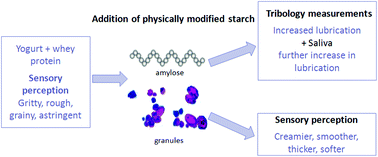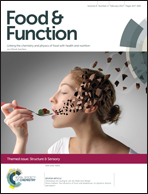The role of starch and saliva in tribology studies and the sensory perception of protein-added yogurts
Abstract
Increasing the protein content of yogurts would be a good strategy for enhancing their satiating ability. However, the addition of protein can affect product palatability, contributing astringency or an inhomogeneous texture. Increasingly, studies mimicking oral tribology and oral lubrication have been attracting interest among food researchers because of their link with oral texture sensations. In the present study, four double-protein stirred yogurts were prepared by adding extra skimmed milk powder (MP) or whey protein concentrate (WPC) and by adding a physically modified starch to each (samples MPS and WPCS, respectively) to increase the consistency of the yogurts. The lubricating properties of the four yogurts were examined by tribological methods with the aim of relating these properties to the sensory perception described by flash profiling. Samples were also analysed after mixing with saliva. The tribology results clearly showed that addition of starch reduced the friction coefficient values regardless of the type of protein. Saliva addition produced a further decrease in the friction coefficient values in all the samples. Consequently, adding saliva is recommended when performing tribology measurements of foods in order to give a more realistic picture. The sensory results confirmed that the addition of starch reduced the astringent sensation, especially in sample WPC, while the MP and MPS samples were creamier and smoother. On the other hand, the astringency of sample WPC was not explained by the tribology results. Since this sample was described as “grainy”, “gritty”, “rough”, “acid” and “sour”, further studies are necessary to investigate the role of the number, size, shape and distribution of particles in yogurt samples, their role in astringency perception and their interaction with the perception of the tastes mentioned. Oral tribology has shown itself to be an in vitro technique that may aid a better understanding of the dynamics of in-mouth lubrication and the physical mechanisms underlying texture and mouthfeel perception.

- This article is part of the themed collection: Structure & Sensory

 Please wait while we load your content...
Please wait while we load your content...